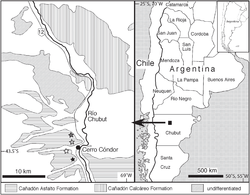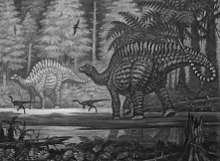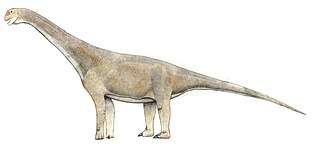Cañadón Calcáreo Formation
The Cañadón Calcáreo Formation is an Oxfordian to Kimmeridgian-aged geologic formation, from the Cañadón Asfalto Basin in Chubut Province, Argentina, a rift basin that started forming since the earliest Jurassic.[1] It was formerly thought to date into the Cretaceous, but the age has been revised with Uranium Lead dating as likely being solely Late Jurassic in age.[2][3][4]
| Cañadón Calcáreo Formation Stratigraphic range: Oxfordian-Tithonian ~160–150 Ma | |
|---|---|
| Type | Geological formation |
| Unit of | Sierra de Olte Group |
| Underlies | Los Adobes Formation |
| Overlies | Cañadón Asfalto Formation |
| Lithology | |
| Primary | Sandstone |
| Other | Shale, tuffite |
| Location | |
| Location | Patagonia |
| Coordinates | 43.2°S 69.1°W |
| Approximate paleocoordinates | 40.6°S 30.0°W |
| Region | Chubut Province |
| Country | |
| Extent | Cañadón Asfalto Basin |
 Formation map and location, Shaded vertically | |
It is a subunit of the Sierra de Olte Group, close to the city Cerro Condor in the Chubut Province of northwestern Patagonia, in southern Argentina. The formation is composed primarily of fluvial sandstones alongside shales and volcanic tuffites[3]
The formation preserves fishes, crocodylomorphs and some dinosaur taxa, as well as conifers.
Geology
The Cañadón Calcáreo Formation is composed mainly of fluvial deposits, that are found close to the Cañadón Asfalto Formation. While originally thought to be part of the Cañadón Asfalto, there is a lack of calcareous rocks, and the geologic faulting and folding is weaker. The Cañadón Calcáreo Formation is overlain by the Chubut Group, the rocks of which lack synsedimentary deformation. The area of the Cañadón Calcáreo also includes lacustrine and palustrine rocks, including shales, pelites, psammites and coarse clastics.[4]
Age
The age of the Cañadón Calcáreo Formation was originally presumed to be Late Jurassic, probably Kimmeridgian to Tithonian in age.[3] However, it has also been suggested to span the entire Late Jurassic, beginning in the Oxfordian, although this could also be because of the uncertainty of the youngest age Cañadón Asfalto Formation.[3][5] A 2009 study of the palynology from a section of the formation revealed an age that was Hauterivian, which suggests that the formation extends from the Late Jurassic into the Early Cretaceous.[4]
Dinosaurs
An unnamed brachiosaurid sauropod is also known from the Cañadón Calcáreo Formation. It is known from a single humerus.[6]
| Dinosaurs reported from the Cañadón Calcáreo Formation | ||||||
|---|---|---|---|---|---|---|
| Genus | Species | Location | Stratigraphic position | Material | Notes | Images |
| Brachytrachelopan[3] | B. messai[3] | Patagonia | Cerro Condor | Partial articulated skeleton including a nearly complete presacral column.[3] | A dicraeosaurid sauropod closer to Dicraeosaurus than Amargasaurus.[3] |  |
| Pandoravenator[5] | P. fernandezorum[5] | Central Patagonia | Chubut[5] | Partial skeleton.[5] | Basal tetanuran close to the base of Averostra.[5] | |
| Tehuelchesaurus[3] | T. benitezii[3] | Patagonia | Cerro Condor[3] | Partial skeleton including skin impressions.[3] | Sauropod proposed to be related to Omeisaurus, but more likely a camarasauromorph.[3] |  |
Crocodylomorphs
| Crocodylomorphs of the Cañadón Calcáreo Formation | ||||||
|---|---|---|---|---|---|---|
| Genus | Species | Location | Stratigraphic position | Material | Notes | Images |
| Almadasuchus[7] | A. figarii[7] | Patagonia | Cerro Condor[7] | Partial skull and postcranial skeleton.[7] | A non-crocodyliform crocodylomorph. The type species is Almadasuchus figarii. Sediments alternatively referred by different authors to the Cañadón Calcáreo Formation or to the Puesto Almada Member of the Cañadón Asfalto Formation.[7] | |
Fishes
| Fishes of the Cañadón Calcáreo Formation | ||||||
|---|---|---|---|---|---|---|
| Genus | Species | Location | Stratigraphic position | Material | Notes | Images |
| Condorlepis[8] | C. groeberi[8] | Patagonia | Cerro Condor[8] | Almost complete skeleton.[8] | A coccolepidid, a member of Chondrostei; a new genus for "Oligopleurus" groeberi Bordas (1943).[8] | |
Plants
| Plants of the Cañadón Calcáreo Formation | ||||||
|---|---|---|---|---|---|---|
| Genus | Species | Location | Stratigraphic position | Material | Notes | Images |
| Pararaucaria[9] | P. delfueyoi[9] | Patagonia | Chubut[9] | Conifer seed cones.[9] | A member of Coniferales belonging to the family Cheirolepidiaceae, a species of Pararaucaria.[9] | |
See also
- List of dinosaur-bearing rock formations
- Lotena Formation, contemporaneous formation of the Neuquén Basin
- Los Molles Formation, contemporaneous formation of the Neuquén Basin
References
- Figari et al., 2015, p.142
- Cúneo, Rubén; Ramezani, Jahandar; Scasso, Roberto; Pol, Diego; Escapa, Ignacio; Zavattieri, Ana M.; Bowring, Samuel A. (November 2013). "High-precision U–Pb geochronology and a new chronostratigraphy for the Cañadón Asfalto Basin, Chubut, central Patagonia: Implications for terrestrial faunal and floral evolution in Jurassic". Gondwana Research. 24 (3–4): 1267–1275. doi:10.1016/j.gr.2013.01.010. ISSN 1342-937X.
- Novas, F.J. (2009). The Age of Dinosaurs in South America. Indiana University Press. pp. 1–458. ISBN 978-0253352897.
- Volkheimer, W.; Gallego, O.F.; Cabaleri, N.G.; Narváez, P.L.; Silva Nieto, D.G.; Páez, M.A. (2009). "Stratigraphy, palynology, and conchostracans of a Lower Cretaceous sequence at the Cañadón Calcáreo locality, Extra-Andean central Patagonia: age and palaeoenvironmental significance". Cretaceous Research. 30 (2009): 270–282. doi:10.1016/j.cretres.2008.07.010.
- Rauhut, O.; Pol, D. (2017). "A theropod dinosaur from the Late Jurassic Cañadón Calcáreo Formation of Central Patagonia, and the evolution of the theropod tarsus". Ameghiniana. 54 (5): 539–566. doi:10.5710/AMGH.12.10.2017.3105.
- Rauhut, O.W. (2006). "A brachiosaurid sauropod from the late Jurassic Cañadón Calcáreo Formation of Chubut, Argentina". Fossil Record. 9 (2): 226–237. doi:10.1002/mmng.200600010.
- Diego Pol; Oliver W. M. Rauhut; Agustina Lecuona; Juan M. Leardi; Xing Xu; James M. Clark (2013). "A new fossil from the Jurassic of Patagonia reveals the early basicranial evolution and the origins of Crocodyliformes". Biological Reviews. 88 (4): 862–872. doi:10.1111/brv.12030. PMID 23445256.
- Adriana López-Arbarello; Emilia Sferco; Oliver W.M. Rauhut (2013). "A new genus of coccolepidid fishes (Actinopterygii, Chondrostei) from the continental Jurassic of Patagonia". Palaeontologia Electronica. 16 (1): 7A.
- Escapa, I.H.; Cúneo, N.R.; Rothwell, G.; Stockey, R.A. (2013). "Pararaucaria delfueyoi sp. nov. from the Late Jurassic Cañadón Calcáreo Formation, Chubut, Argentina: Insights into the Evolution of the Cheirolepidiaceae" (PDF). International Journal of Plant Sciences. 174 (3): 458–470. doi:10.1086/668612. hdl:11336/1531.
Bibliography
- Figari, Eduardo G.; Roberto A. Scasso; Rubén N. Cúneo, and Ignacio Escapa. 2015. Estratigrafía y evolución geológica de la Cuenca de Cañadón Asfalto, Provincia del Chubut, Argentina. Latin American Journal of Sedimentology and Basin Analysis 22. 135–169. Accessed 2018-09-10.
Further reading
| Wikimedia Commons has media related to Cañadon Calcareo Formation. |
- O. W. M. Rauhut, J. L. Carballido, and D. Pol. 2015. A diplodocid sauropod dinosaur from the Late Jurassic Cañadón Calcáreo Formation of Chubut, Argentina. Journal of Vertebrate Paleontology 35(5):e982798:1-8
- O. W. M. Rauhut, K. Remes, R. Fechner, G. Cladera, and P. Puerta. 2005. Discovery of a short-necked sauropod dinosaur from the Late Jurassic period of Patagonia. Nature 435:670-672
- T. H. Rich, O. Giménez, R. Cúneo, P. F. Puerta, R. Vacca and P. A. Vickers-Rich. 1997. Primer registro de un camarasáurido primitivo en el Gondwana patagónico [First record of a primitive camarasaurid in Patagonian Gondwana]. Ameghiniana 34(4):540